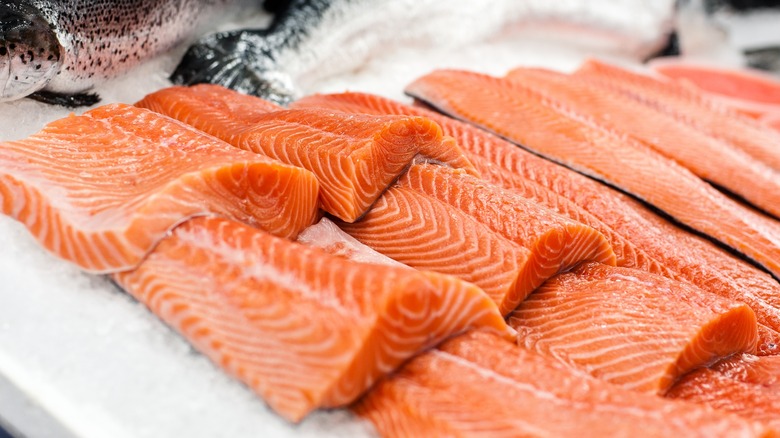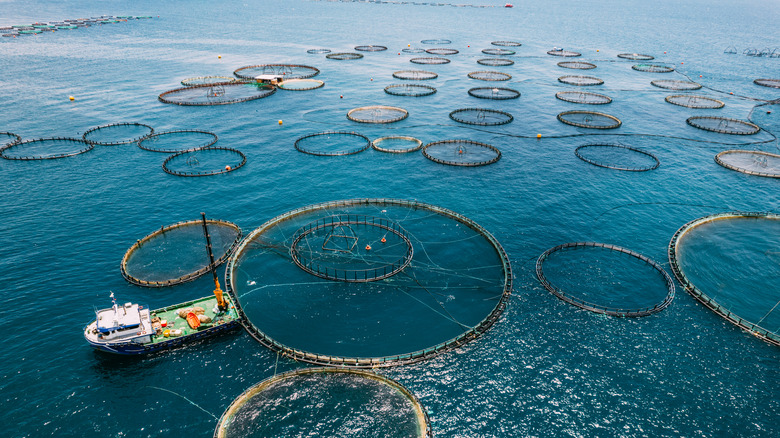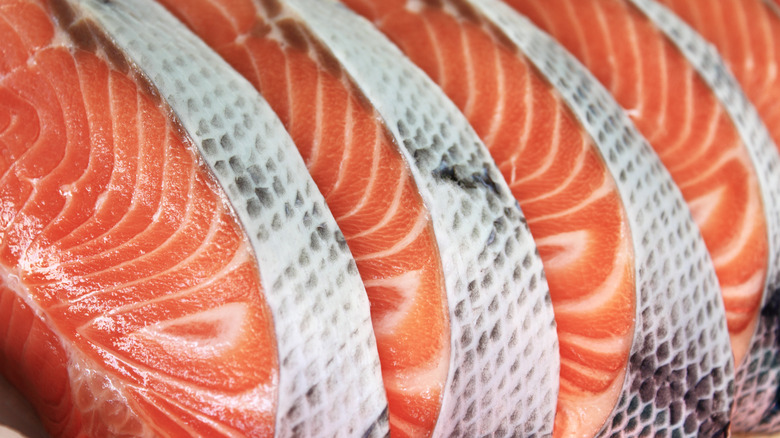The Best Time Of Year For Fresh Salmon
In many ways, buying food is easier than ever, but that convenience comes at a cost. If we can buy salmon every single day of the year, how are we supposed to know when the fish is fresh and in season? To complicate the situation even more, there are multiple types of salmon from different parts of the world and their seasons don't always match up. The truth is that many varieties of farmed and wild-caught salmon are available fresh all year long thanks to modern farming and fishing practices. Generally speaking, wild-caught salmon is in season and at its peak in the summer, with some varieties extending into the middle of autumn.
The season starts with king salmon, also known as chinook salmon, starting in late April and running until late July. Sockeye comes into season next starting in early June and only running until late July. Pink salmon is more likely to be sold in a can rather than fresh, but its season runs from late July to early September. Coho's season runs from late July to mid-October. Alaskan chum salmon is fished from late July to early September, whereas this type of fish is caught until mid-October in the Pacific Northwest. A very small number of salmon fisheries operate year-round, but they are the exception to the rule.
Do farm-raised salmon have a season?
The short answer is no. Farm-raised salmon don't have a season. To understand why this is the case, we must understand what seasonality means. Wild-caught salmon is in season when commercial fisheries are actively catching salmon and selling them to you through your grocery store. The vast majority of salmon fisheries are only active for a few months out of the year. That's partly to avoid overfishing but also because of salmon migrations. Salmon are anadromous, meaning they reproduce in freshwater rivers but migrate out to the ocean to mature. So every year, salmon are migrating in and out of the ocean and fisheries are active based on when salmon will be in the area.
Farm-raised salmon don't migrate and all of the fish are raised in order to harvest them, so there's no concern over overfishing and they don't have to plan around migration patterns. Farm-raised salmon is harvested all year round. Because of this, farm-raised salmon is always in season — which is a lot like saying it has no season.
This lack of seasonality can make it difficult to tell when farm-raised salmon is fresh. Salmon farms aren't required to display the harvest date on the fish you're selling. Your best bet would be to learn how to identify fresh fish from less fresh options.
Tips for buying fresh salmon
Even if the wild-caught salmon is in season, that doesn't necessarily mean that the fish you're buying at the store is fresh. If you don't live near the ocean or within a reasonable distance of where seafood is local, the likelihood that what you are buying is at peak freshness is quite small. Fish doesn't stay fresh for very long and should be eaten or frozen within two days of being removed from the water. Frozen versions may feel like you're getting a lower quality product but, if you don't live near salmon, buying frozen or canned products is actually a better way to go to get the freshest salmon possible.
If you're having trouble identifying what species of fish you're buying, read the label carefully. It should state what type of salmon you're buying along with other facts such as where it was harvested, where it was processed, and whether it's wild-caught or farm-raised. If you're still having trouble, ask whoever is at the seafood counter. They should be able to help you identify what fish it is and which varieties are the freshest options on any particular day.


